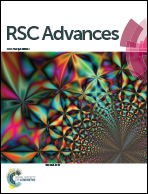Schiff-base polymer derived nitrogen-rich microporous carbon spheres synthesized by molten-salt route for high-performance supercapacitors†
Abstract
Nitrogen-rich microporous carbon spheres (NMCSs) have been prepared via thermal treatment of Schiff-base polymer monomers of melamine and terephthalaldehyde in the presence of a molten-salt ZnCl2/KCl system. The use of ZnCl2 and KCl in the reaction allows for NMCSs with a high specific surface area of 1929 m2 g−1 and pore volume of 0.85 cm3 g−1. More importantly, most of the pore volume is contributed to micropores, making it an ideal electrode material for high-performance supercapacitors. When tested as supercapacitor electrodes, NMCSs delivered an excellent specific capacitance of 365 F g−1 at a current density of 0.5 A g−1 and still maintained 230 F g−1 even at 10 A g−1. Moreover, a very stable cycle life with 94% capacitance retention was observed after 10 000 charge–discharge cycles at a current density of 3 A g−1. With regard to the inexpensive precursors, simple and environmentally-friendly synthetic route, this novel molten salt strategy holds great potential for the industrial manufacture of NMCSs for use in energy storage and conversion.


 Please wait while we load your content...
Please wait while we load your content...